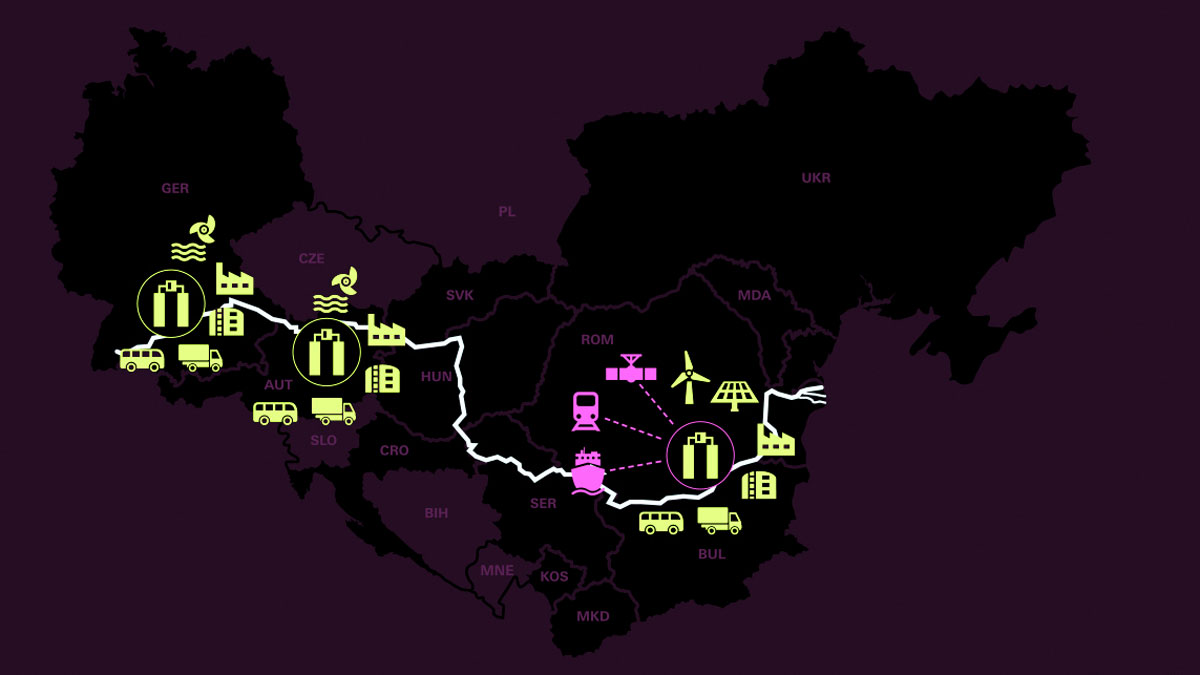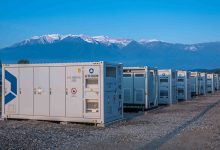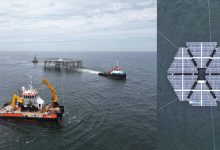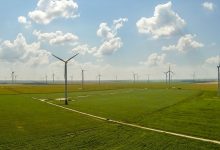Green H2 Blue Danube: A Hydrogen Project of European Dimensions
VERBUND, Austria’s leading energy utility and one of the largest producers of hydroelectricity in Europe, is developing the Green Hydrogen Blue Danube project in conjunction with technology partners and buyers of green hydrogen within the framework of the European Commission’s Important Projects of Common European Interest (IPCEIs) initiative.
The project involves various stakeholders along the value chain. Romania’s state-owned electricity producer Hidroelectrica is involved in the project as co-investor in renewable energy and hydrogen production in SEE. The goal is to create a trans-European green hydrogen value chain – from production to transportation to purchase by industrial and mobility customers.
The following partners are involved in the project’s development: VERBUND (generates green electricity and green hydrogen and supplies it to consumers; project coordinator, Austria); Agrana (buys green hydrogen to produce second-generation bioethanol, Austria); AVL (developing a hydrogen powertrain for maritime transport, Austria); Bayernoil (buys green hydrogen for decarbonisation of refinery processes, Germany); Bosch (buys green hydrogen through customers with stationary fuel cells, Germany); Chemgas Shipping (provides the fleet for maritime transport, Netherlands); Cummins (supplies electrolysis technology, Belgium); DB Schenker (buys green hydrogen for its logistics fleet, Austria and Germany); Donau Tankschifffahrtsgesellschaft (operates the shipping fleet on the River Danube, Austria); Gunvor Raffinerie Ingolstadt (buys green hydrogen for decarbonisation of refinery processes, Germany); Hydrogenious LOHC Technologies (supplies technology to LOHC, Germany); Hidroelectrica (co-investor in renewable energy and hydrogen production in SEE, Romania); ÖBB (transports hydrogen by rail and truck, Austria); Siemens Energy (supplies electrolysis technology, provides facility planning and EPC services, Austria and Germany); TECO 2030 (supplies technology for hydrogen powertrains for maritime transport, Norway); Worthington (supplies high-pressure cylinders for transporting hydrogen, Austria).
An important building block for the decarbonisation of Europe
This project will greatly advance decarbonisation by means of green hydrogen – benefiting industrial users and the mobility sector.
VERBUND deems green hydrogen an important building block for the decarbonisation of Europe and intends to establish green hydrogen as a second green energy carrier next to green electricity in its portfolio. To underline these ambitions, VERBUND has already launched several flagship projects, most prominently the construction and operation of one of the world’s largest electrolysis plants as part of the H2FUTURE project with voestalpine, Siemens, APG, K1-MET and TNO, funded by the Fuel Cells and Hydrogen Joint Undertaking (FCH JU). VERBUND also developed and now operates the HOTFLEX project, which deploys a highly innovative reversible solid oxide electrolyser and fuel cell. VERBUND is also engaged in several further projects related to the production, storage and use of green hydrogen.
Green hydrogen is produced through electrolysis of renewable electricity. It emits significantly less carbon dioxide when used, because natural gas is substituted in the production of hydrogen. In the mobility sector, green hydrogen is an alternative source of energy to replace fossil fuels, especially in freight transport.
From today’s viewpoint, future needs for green hydrogen will only partially be met from domestic production. To a much higher degree, Austria, just like most Western-European countries, will rely on imports of green hydrogen to achieve their ambitious climate targets. A European green hydrogen economy will include all aspects from generation to transport and utilization.
“VERBUND is embracing green hydrogen, because as a producer of green electricity we believe that this sustainable product will greatly further the achievement of climate targets. At VERBUND we are taking the lead here, working with distinguished partners from Austria and other European countries to help green hydrogen achieve a breakthrough. In terms of sector integration and sector coupling, we are focusing on new infrastructure, innovative technologies, and sustainable business models,” said Michael Strugl, Deputy CEO of VERBUND.
The first phase of the project focuses on production and use of green hydrogen in Austria and Bavaria.
Given that Austria will not be able to produce enough hydrogen, the second phase of the project will focus on the production of green hydrogen from renewable electricity in south-eastern Europe. There, wind, solar and hydropower will be converted into hydrogen directly on site to harness Europe’s renewable resources that otherwise could not be utilised owing to a lack of electricity transmission capacity. This hydrogen will then be transported via the River Danube, a long-established European transport corridor (TEN-T), to hydrogen users in Austria and Germany.
The concept
- Produce green hydrogen on a large scale off-grid in South-East Europe using wind and solar energy
- Transport hydrogen via the River Danube to hydrogen users in countries of the Interreg Danube Transnational region
- Set up the necessary hydrogen infrastructure in the participating member states along TEN-T core corridors
The benefits
- Contribute to achieve climate objectives of Member States
- Reduce dependence on fossil energy imports: renewables made in Europe
- Increase security of energy supply: increased flexibility and resilience
- Strengthen key European industry sectors, create jobs and spill-over effects
Key facts
- 2,000 MW off-grid wind and solar energy production
- 1,800 MW electrolysis for hydrogen production
- 40 hydrogen transport barges
- 80,000 tonnes of hydrogen for industry, power + mobility hubs (500 trucks / 100 HRS) along the Danube
In a nutshell
- Use the Danube waterway for cost-efficient and sustainable transport of hydrogen in the Danube region
- Utilise the Danube sea ports and inland ports for storage and intermodal transport of green hydrogen
- Bring green hydrogen to early movers in the industry and mobility sectors and roll out the hydrogen economy along TEN-T core corridors
- Strengthen and decarbonise both traditional and new industry sectors in Europe all along the hydrogen value chain
The vision: Spill-over effects – Connect the Danube value chain to the River Rhine, to the Black Sea, to pipeline networks across Europe and to maritime ports.







